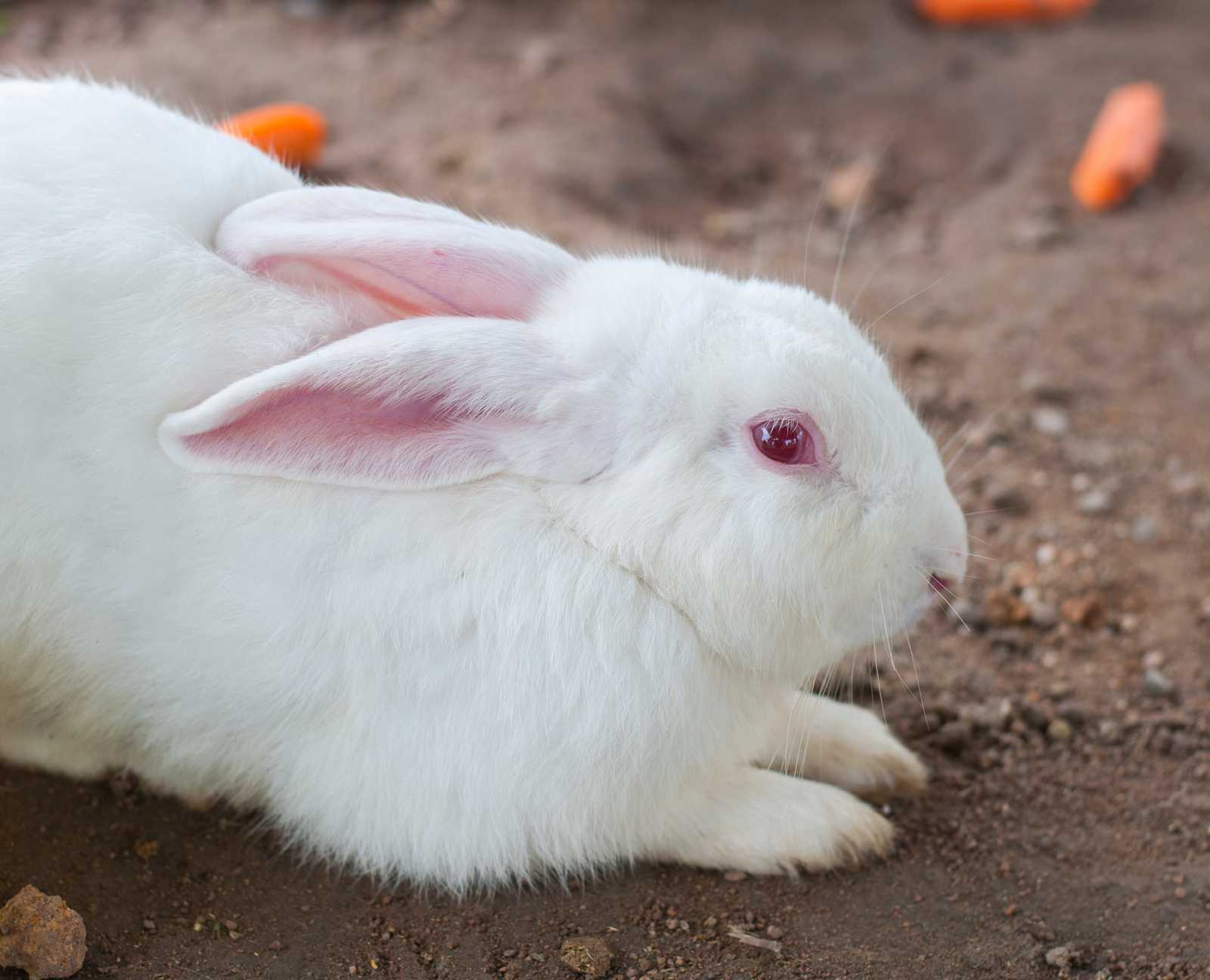A red-eyed rabbit is a sight to behold. We typically associate red eyes with predators or even demonic creatures of yore, so what on Earth are they doing adorning the face of your adorable little rabbit?
There are actually several reasons why a rabbit may have red eyes, none of which have to do with them suddenly becoming demonic or going over to the Dark Side (those would be yellow eyes, obviously.)
With that in mind, let’s take a closer look at red eyes in rabbits and what they mean.
Rabbits and Albinism
The most common explanation for red eyes in rabbits by far is that it is a form of albinism. An albino rabbit will lack pigmentation in its eyes or fur, meaning it won’t have the kind of color that would normally block out the criss-crossing red veins in its eyes. Albino rabbits always have translucent fur that appears white but lacks pigmentation.
This is not merely relegated to the world of rabbits, either. Humans with ocular albinism tend to have blue eyes, but if the blood vessels inside show through, their eyes can instead appear pink or red, just like these albino rabbits.
It is important to remember that albinos of any species tend to be extremely sensitive to sunlight. As we’ll explore later, this can have severe ramifications for the health of your rabbit. That being said, red eyes are a perfectly natural feature in albino rabbits, and should not be cause for alarm.
Albinism was initially a genetic mutation that blocked the creation of tyrosinase, an enzyme that creates pigmentation, which in turn gives a creature color in both its fur/hair and eyes. Albino rabbits lack melanin in both their fur and eyes as a result of this.
This genetic mutation has been deliberately bred into some breeds of rabbits for the purpose of rarity and petkeeping. All rabbits with white fur have this gene.
The actual reason for the red eyes themselves has to do in part with how the rabbit’s eye reflects light. In a rabbit with pigmentation, light is reflected via the melanin particles. If those particles are smaller, the rabbit will have blue eyes, whereas if they are larger, they will have brown eyes. This is obviously an oversimplification and there are many permutations to this, but that’s the basic setup.
Albino rabbits, meanwhile, lack melanin particles to reflect light, and so the iris instead reflects light as it passes through the blood vessels. This is what gives albino rabbits their red-eyed look.
Albino Rabbit Breeds
There are by now several rabbit breeds that have albinism genes, and any rabbit can theoretically carry it, since it is a recessive gene. As such, a baby rabbit needs the gene from both parents for it to show up phenotypically. That said, some rabbit breeds have been engineered to produce it more than in nature. Some of the most common such albino-bred rabbit breeds are:
- Himalayan Rabbits, which have a white body, but a black head, feet, tail, and ears. These are among the most popular rabbits to be kept as pets due to their calm nature.
- Californian Rabbits, which are so similar to Himalayans they are sometimes confused for them.
- Lionhead Rabbits, which are marked by unique tufts of fur that can look like a lion’s mane.
- Angora Giant Rabbits, which are the largest rabbit breed officially recognized by the American Rabbit Breeders Association.
That being said, you will almost never find albino rabbits in the wild. While it is possible that two rabbits with the recessive gene will meet and mate in the wild, it is unlikely that the resulting progeny will survive long enough to grow to adulthood and mate themselves. This is due to several factors, not the least of which being that their white translucent coat is hardly ideal camouflage in most forest, desert, and grassland settings. Rabbits need camouflage as protection from predators, while bright white coats are practically a “Free Dinner Here” sign.
What’s more, it can be hard for wild rabbits to survive in the heat and sun with albinism. Their skin can burn, since their fur will afford little to no protection from the sun. In addition, rabbits with red eyes often have blurry vision. While this isn’t too bad for rabbits who live in captivity, in the wild, rabbits need every advantage they can get to survive. Having blurry vision makes it that much harder for them to see predators.
Albino Rabbits’ Health
If you are worried about albino rabbits being unhealthy, don’t be. Albinos are perfectly healthy, but they do require extra care when it comes to sunlight. Extended exposure to sunlight can and very possibly will burn them. In addition, the red eyes are more sensitive to light than those of other rabbits. Rabbits tend to be most active at dawn and dusk, and it’s in lighting conditions such as those that they see best. When there is a lot of light, they may feel overwhelmed. You should thus take care to dim the lights whenever possible. If you take your rabbit outside, make sure there is plenty of room for them to seek out shade. You may even want to put unscented sunscreen on your rabbit, especially around the ears, to protect its sensitive, less-protected skin from the sun.
That said, in other ways your albino rabbit should be perfectly fine. Its internal organs and immune system should be every bit as healthy as a “regular” rabbit.
Even though albino rabbits can see, their vision may be different from that of other rabbits. Albino rabbits have fewer rods, which means that they register light and color differently.
Non-Albino Rabbits with White Eyes
However, if your rabbit does not have translucent white fur but instead has brown or black fur, or even white fur that is pigmented, the answer is likely not albinism but irritation. Your rabbits’ eyes aren’t meant to look like this, and are thus a sign of a problem.
Less rosy is the possibility that your red-eyed rabbit can also be suffering from a medical condition, such as hyperemia, which is indeed otherwise known as “red-eye.” This deals directly with ocular inflammation as a result of excessive blood flow.
Potential causes for hyperemia include:
- Bacterial and fungal infections
- Conjunctivitis
- Glaucoma
- Damage to the eye
- Overgrown teeth pressing against the ocular socket
Symptoms include:
- Poorer vision
- Swollen eyelids
- Hair loss around its eyes
- More tear production than usual
- Grinding teeth
- Depression and ennui
These issues may be serious, and the addition of red inflamed eyes should indicate that they are. If your rabbit has red eyes and some of these symptoms, see a veterinarian as soon as possible. Among the treatments they may prescribe are antibiotics, ointments, and eye drops. If a tooth placing pressure on the ocular region is the culprit, the tooth in question may require extraction. In addition, you’ll want to make sure your rabbit’s eyes are regularly checked to make sure that they are not getting worse.
If hyperemia goes untreated, it may wind up costing your rabbit its eyesight. You naturally don’t want this to happen, so make sure that you are vigilant about acting on warning signs.
There are many potential reasons why your rabbit has red eyes. Maybe it’s albino, and maybe it has health issues. Either way, you need to make sure that you accommodate their vision needs as well as any special medical needs your rabbit may require to live a healthy life.

